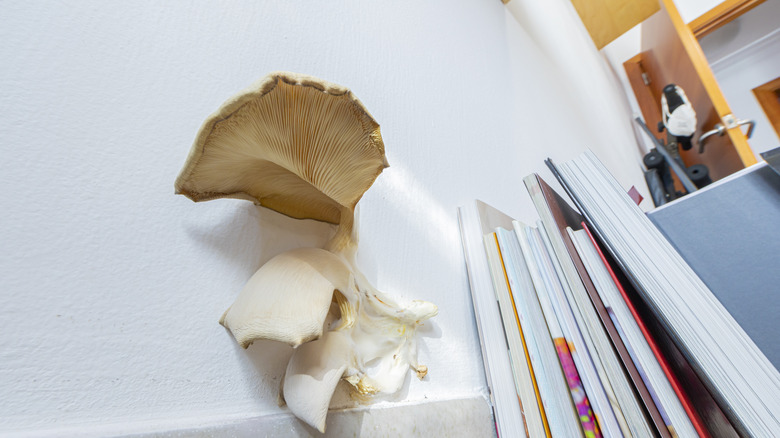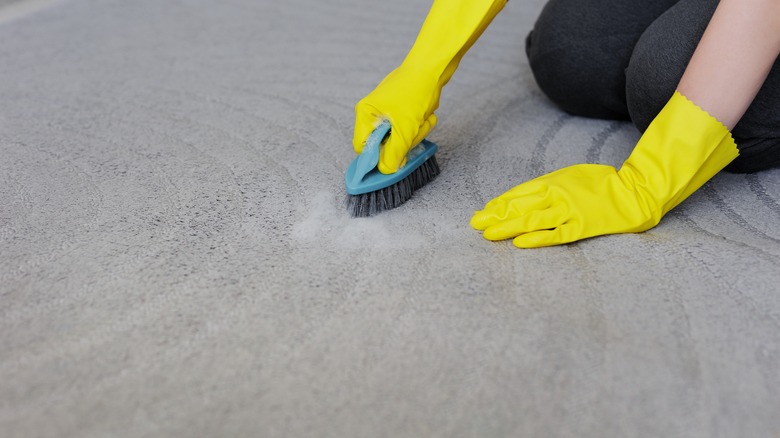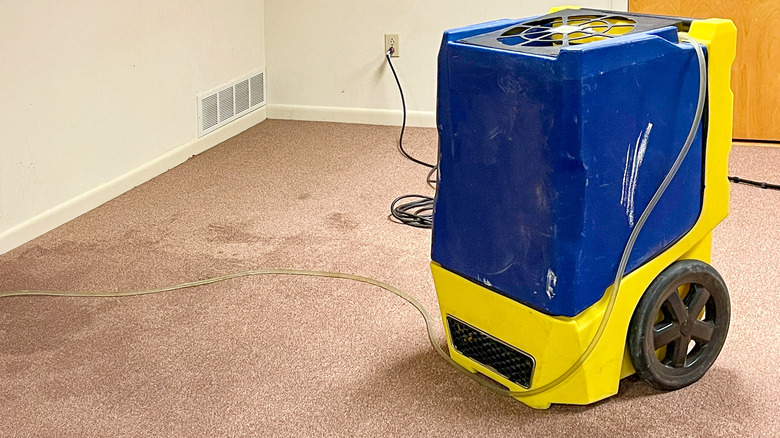What To Do If You Find Mushrooms Growing In Your Bedroom
If you've arrived here because you are seeking advice on the mushroom varieties you can grow at home or thought this was a fungi fan page, you'll be disappointed. While growing your own mushrooms at home can be a fun and delicious activity, having fungi growing out of your carpet in the bedroom is neither of these things. There's being a fan of shows like "The Last of Us," where fungal spores infect humans and control their brains, then there's actually living that scenario, which no one wants to do.
Say you've discovered a terrarium-gone-wrong in a corner of your bedroom. First, take a sigh of relief that it's not your mattress. Mushrooms like dark, damp environments, and if your sleeping space accommodates this need thanks to a leak or excess humidity, you may find some mycelial life popping up through your carpet fibers. They usually sprout after a big spill of some kind has left the floor moist and fungal spores have found their way inside your home through entryways and on people and pets.
You need to eradicate the mushrooms and ensure they stay away. Removing all the visible growth and cleaning then drying your carpet is imperative, although sometimes other measures, like replacing the carpet, may be necessary. You probably don't know what type of fungus you are dealing with, so you'll need gloves, tall boots, a ventilator, and goggles. Cleaning products are also a must, though exactly what you'll need varies depending on your specific mushroom situation.
Remove all the mushrooms and clean the carpet
Assess the area in which the mushrooms are growing. When it comes to removing problematic mold — or, in this case, mushrooms — from your carpet, you need to be thorough. Note any outlying areas of carpet that are moist; they have the potential to grow more fungi. Start by pulling out and scraping up all the mushrooms with gloved hands. You could also cover your hands with a trash bag and pick them out. If the mushrooms are tricky to pull up by hand, try tackling them with a knife or brush — though avoid pulling out the fibers of your carpet if you plan to keep it. Using a vacuum cleaner might help, too, but don't use the high suction setting or run it over very wet areas as this can damage your machine. Try to get as many of the mushrooms out of the carpet as you can before you start cleaning.
Once you've cleared the area of fungi, you need to eradicate the spores. If you're planning to replace the carpet, you could use a bleach-based cleaning product or a mix of 1 cup of household bleach to a gallon of water on the subfloor to clear away any residue. If you hope to keep the carpet, consider using a steam or carpet cleaner or a cleaning spray that will not stain the fibers. Anti-fungal products may help — whether they're effective depends on the level of fungal growth and the damage to the carpet. If a leak is responsible for the moist carpet, make sure it's fixed, otherwise the mushrooms could regrow.
Keep your carpet dry to prevent mushrooms from growing back
Spores can be tracked in from outside, meaning your carpets are always at risk of being infected by fungi. If spills or leaks occur, dry and clean the area as soon as possible. The best way to dry wet carpet is to lay down towels, set up powerful fans (you can rent or buy them) in the room, and open the windows and air vents to remove moisture from the air. From there, you need to keep it dry.
The thing with mushrooms is that just pulling them out will not keep them at bay. You need to ensure the spores are taken care of, too. Adding a mold-inhibiting layer under new flooring is a preventative measure, as is keeping your home from producing too much humidity. Invest in a good dehumidifier, especially if you've had mushrooms growing out of your carpets in the past. This will keep them from coming back and new spores from sprouting. In the worst cases, removing and replacing your carpet may be the best option.


